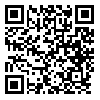Volume 22, Issue 2 (Summer 2020)
Advances in Cognitive Sciences 2020, 22(2): 22-32 |
Back to browse issues page
1- Assistant Professor of Medical Engineering, Ati Negar Cognitive Data Processing Institute, Department of Cognitive Sciences, Tehran, Iran
Abstract: (2393 Views)
Introduction: The Persian versions of the Strategic Thinking Scales in the country are all self-reporting. It is also not suitable for military organizations. The present study aimed to investigate the validity and reliability, as well as to extract the normative scores of the Military Managers’ Strategic Thinking Test (STMT) based on situational judgment and the components of intellectual inclusiveness, intellectual humility, and intellectual flexibility.
Methods: The statistical population in this study included all managers and staff of the National Defense University in the first half of 2019, of which 189 people were evaluated. The Military Managers Strategic Thinking Test was designed by Weyhrauch (2017) and under the auspices of the US Army Institute for Military Studies in Behavioral and Cognitive Sciences. The test consists of 12 scenarios in which the respondent chooses one answer in each scenario. The Goldman Strategic Thinking Questionnaire (2007) was also used to assess criterion validity.
Results: Analysis of research data showed that the structure based on three subscales using the confirmatory factor analysis to explain and fit a good situation. Also, the reliability coefficients of internal consistency and test-retest were optimal. Accordingly, the researcher's hypothesis that the structure is based on three components of intellectual inclusiveness, intellectual humility, and intellectual flexibility is confirmed.
Conclusion: It seems that research evidence supports the consideration of all three components as cognitive dimensions for strategic military thinking, and this test can be used in military assessments.
Methods: The statistical population in this study included all managers and staff of the National Defense University in the first half of 2019, of which 189 people were evaluated. The Military Managers Strategic Thinking Test was designed by Weyhrauch (2017) and under the auspices of the US Army Institute for Military Studies in Behavioral and Cognitive Sciences. The test consists of 12 scenarios in which the respondent chooses one answer in each scenario. The Goldman Strategic Thinking Questionnaire (2007) was also used to assess criterion validity.
Results: Analysis of research data showed that the structure based on three subscales using the confirmatory factor analysis to explain and fit a good situation. Also, the reliability coefficients of internal consistency and test-retest were optimal. Accordingly, the researcher's hypothesis that the structure is based on three components of intellectual inclusiveness, intellectual humility, and intellectual flexibility is confirmed.
Conclusion: It seems that research evidence supports the consideration of all three components as cognitive dimensions for strategic military thinking, and this test can be used in military assessments.
Keywords: Situational judgment test, Strategic thinking, Intellectual flexibility, Intellectual humility, Intellectual inclusiveness
Type of Study: Research |
Received: 2020/02/15 | Accepted: 2020/05/23 | Published: 2020/06/30
Received: 2020/02/15 | Accepted: 2020/05/23 | Published: 2020/06/30
| Rights and permissions | |
 |
This work is licensed under a Creative Commons Attribution-NonCommercial 4.0 International License. |





